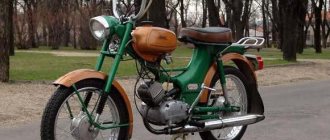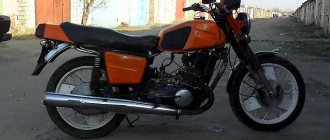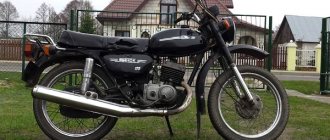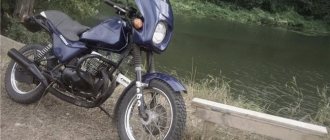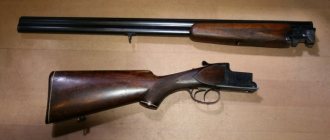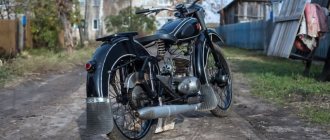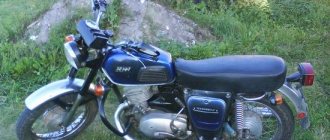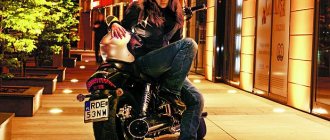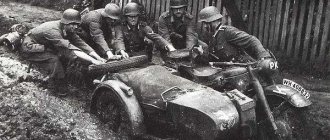Author: Oleg
02 June 2015 14:37
Tags: car motorcycle sidecar motorcycle
14382
11
Motorcycles with sidecars, in demand in the middle of the last century, are turning into rarities. They are becoming less and less common on our roads, giving way to more modern means of transportation.
0
See all photos in the gallery
However, this type of transport still exists, enjoying steady demand among residents of rural areas, extreme sports enthusiasts and originals. The latter continue to persist in the opinion that a motorcycle with a sidecar is incredibly cool. And not only in matters of transporting hay and potatoes. By the way, we sincerely believe that the coolest motorcycles with a sidecar are the Ural. Honestly, without any advertising and simply because their design is not outdated, but has turned into a very interesting vintage. Not to mention the hidden off-road power. But today we will look at completely different motorcycles with a sidecar.
002_moto_1210_058
The crew of Veniamin Gubin and Alexey Dubskikh on the M-72 on the track of the first “official” motocross in Irbit, 1945.
The crew of Veniamin Gubin and Alexey Dubskikh on the M-72 on the track of the first “official” motocross in Irbit, 1945.
In preparation for the 1947 national championship in two disciplines - “ring” and “cross”, special sports strollers were produced at the Irbit Motorcycle Plant (for the first time in the country on an industrial basis). They called them “TT”, by analogy with the famous race on the Isle of Man - “Tourist Trophy”. The stroller was universal - both for road racing and cross-country. On the eve of the championship of the Soviet Union, the championship of the RSFSR was held in Serpukhov. Six Irbit crews took off using updated equipment. For road racing, an M-75 engine was installed in a lightweight chassis, and for cross-country racing, an M-72 engine was installed. Using such equipment, the Irbitsk team was beyond competition, and the pair Alexander Lukoyanov/Nikolai Sachkov became the absolute winners of the RSFSR - both in road racing and cross-country. This crew also performed brilliantly at the USSR Championships in Tallinn - victory on the “ring” and second place in the cross-country. Of course, the “TT” stroller was not perfect and had a rigid wheel suspension (racers called it a “double-support”). Torsion bar suspension appeared only in the early 50s.
012_moto_1210_058
The 1969 M-64K with a 750 cc engine and a lever front fork did not justify itself.
The 1969 M-64K with a 750 cc engine and a lever front fork did not justify itself.
Until the early 70s, Soviet “strollers” did not travel abroad. In 1971, they were finally released to three stages of the FIM Cup, the forerunner of the European Championship. The team consisted of three crews: Irbit couples Anatoly Sibirtsev/Igor Nikonov and Valentin Telegin/Petr Sosnovskikh, Moscow duo Valery Alfeev/Alexander Kuzovkin. Our racers competed on 45-horsepower IMZ Cross-750 cars. And although they consistently ranked in the top ten, they had to fight not on equal terms - the rivals’ motorcycles were 30–40 kilograms lighter and much more powerful than ours (60–70 hp). The foreigners were especially amazed by the strollers. It was much more convenient to work in them; they weighed 15–20 kilograms lighter than ours. Pyotr Sosnovskikh and Igor Nikonov (craftsmen from God), with the permission of their foreign colleagues, carefully studied European technology, making the appropriate measurements. The next year, Europe, previously amazed by the “tank-like” appearance of Russian cars, saw “civilized” motorcycles. At the very first stage in Belgium, the crew of Anatoly Sibirtsev/Igor Nikonov became winners, and Valentin Telegin and Pyotr Sosnovskikh took third place!
009a_moto_1210_058
The Cross-650 motorcycle was prepared for the factory team for the 1962 USSR Championship.
The Cross-650 motorcycle was prepared for the factory team for the 1962 USSR Championship.
38 crews came to Irbit for the national championship, 9 of them were already champions of the USSR at different times (the crew title is always based on the driver). Among them are Evgeny Kosmatov (Moscow), Alexander Razorenov and Yuri Sokolov (both from the Investigative Committee of the USSR Armed Forces), Vladimir Volchkevich (Leningrad), Irbitsk residents Genrikh Vartanyan, Veniamin Gubin, Anatoly Bykov and others. The result amazed everyone. In the free class “from 350 cm³ and above” the entire podium was occupied by representatives of one team - the Irbit Motor Plant. The title of USSR champions was won by the crew of Henrikh Vartanyan/Victor Karzhavin, the duo Leonid Leshkov/Evgeniy Korolev took the silver, and the bronze medal went to the pair Veniamin Gubin/Gennady Borodin. Yes, this is the same Veniamin Gubin from the distant “forty-fifth”!
The next new product in 1969 was the M-64K, already with a 750 cc engine, a lever front fork and an enlarged steering column bearing. However, this motorcycle did not receive recognition. The reason was the gathering of all four crews of the factory team at the national championship in Vilnius. There is only one reason - the steering column bearing is jammed.
City
When driving in the city, in dense traffic of cars and other vehicles, try to avoid unnecessary lane changes, and even more so “playing tag.” The rather sharp handling of a wheelchair user, in principle, allows this to be done, but this aggressive driving style, firstly, irritates surrounding drivers, and secondly, creates emergency situations, if only because the motorcyclist may not have time to react to a suddenly appearing obstacle, and high mass and brakes that are more inert than those of a single person can only aggravate the consequences. It is best to drive in the far right lane, especially on roads where there is no special lane for route vehicles. As practice shows, this is the safest way to travel around a big city with wide roads. However, just in case, do not forget to visually “scan” the space to the right and right-behind of your wheelchair user; a scooter rider can suddenly and unpredictably jump out of there, and even a cyclist in slow-moving traffic. Always look through this space when turning right for the same reason (and the author would give this recommendation to any driver at all, since he himself sometimes rides a scooter where the traffic rules are prescribed - to the right of the entire flow and no further than 1 meter from the edge of the roadway, and often barely had time to brake in front of cars whose drivers do not consider it necessary to take the extreme right position on the roadway when turning right).
Winter. “Kolyasych”, triumphant...
Driving in winter is a rather controversial issue. The author, in addition to winter “rides” in a wheelchair, also has experience of driving all winter long, but explains this by youth and recklessness: there is certainly no comfort, and even the degree of danger increases significantly. Naturally, everyone decides for themselves whether to travel in winter or not, whether to go out for a ride or stay at home, but there are still some commonly used tips. Warm yourself! If on foot at -5 you are used to walking without a hat with your collar wide open, then before the trip put on twice as much clothing as would be useful in twenty-degree frost. Yes, it hinders your movement, yes, it’s hot for you to get to the motorcycle and start it, but when riding, the cooling conditions for your body are completely different. Your task is to avoid hypothermia and frostbite. Warm up the engine. Let it sit and thresh at idle longer - it won’t overheat, but it will cool down properly after a kilometer. Reduce your overall movement speed relative to summer speed. Maneuver as carefully as possible. Even if you drive on dry asphalt in cold weather, the likelihood of skidding is significantly higher than on wet asphalt in summer.
003_moto_1210_058
The absolute winners of the 1947 RSFSR Championship are Alexander Lukoyanov and Nikolai Sachkov.
The absolute winners of the 1947 RSFSR Championship are Alexander Lukoyanov and Nikolai Sachkov.
Cross-country tracks of that time were significantly different from modern ones - they were laid along country roads, through swamps and fords, through ravines... The circle of such a track was 25–50 kilometers, the entire distance was 50–100 kilometers (several laps). Riders often had to pull the motorcycles out by hand. This is where various devices on motorcycles came from, including handles on the front and rear guards. The stroller had a special seat for the convenience of the wheelchair user while kneeling. On flat sections of the highway, the “passenger” could rest on this pillow.
006_moto_1210_058
From 1952 to 1958, the plant produced M-72K sports motorcycles.
From 1952 to 1958, the plant produced M-72K sports motorcycles.
From 1959 to 1965, the M-61K was mass-produced in Irbit. An overhead valve 650 cc 28-30 hp M-61 engine was installed in the M-72 chassis with the spark plug suspension stroke increased by 20 mm. 855 of these machines rolled off the plant’s assembly line, not counting those motorcycles that were made specifically for Irbitan racers. At the end of the 50s, the M-52K was also produced on the basis of the serial M-52 (working volume 494 cm³).
"Riga-13"
Riga began producing mopeds back in 1958. And since then, many boys have dreamed of their parents giving them a moped for their birthday. This is what they did, so mopeds, and especially the Riga-13, became the first vehicle for many. "Riga-13" began to be produced in 1983. Equipped with a 1.3 hp engine, it accelerated to only 40 km/h. To start from a standstill and move uphill, the “biker” was recommended to help the engine by turning the pedals. "Riga-13" was produced until 1998, becoming the most popular model of the plant.
"Java 350 638"
The first Javas had a 4-stroke engine with a cylinder capacity of 500 cm3, were quite complex, expensive and were not in demand. Then a series of modernizations followed - one of the most successful occurred in 1984. The model turned out to be so successful and in demand that the number of motorcycles produced in the 1980s exceeded 3 million units. “Java 350 638” has repeatedly appeared in films (“Accident – the Cop’s Daughter”, “Rats, or the Night Mafia”, etc.). They even wrote songs about it (“Java” by the Gaza Strip group).
Custom with side trailer
Homemade products come in a variety of varieties. Someone attaches a sidecar from a Pannonia motorcycle to a Japanese chopper, someone even takes a sportbike as a donor... The results are sometimes very funny, like a motorcycle with two sidecars. But there are also decent examples that look much better than all their mass-produced counterparts. Sometimes you come across motor scooters with a sidecar, although often some more powerful maxi-scooter, capable of confidently carrying additional weight, is taken instead.
"Vyatka VP-150"
“Vyatka VP-150” is the first Soviet scooter produced by the Vyatsko-Polyansky Machine-Building Plant. Produced from 1957 to 1966. It is a copy of the Italian Vespa 150GS scooter from 1955. Before the scooter, the plant produced Shpagin submachine guns. “Vyatka” could not reach the level of popularity of the PPSh and its older sister Vespa, but a million scooters sold is also a very worthy result. They say that this was the most “disco” transport, and all because it allowed men to get to the party with clean pants that were not “stained” with dirt, and women did not have to carry spare “working clothes” in their purses.
